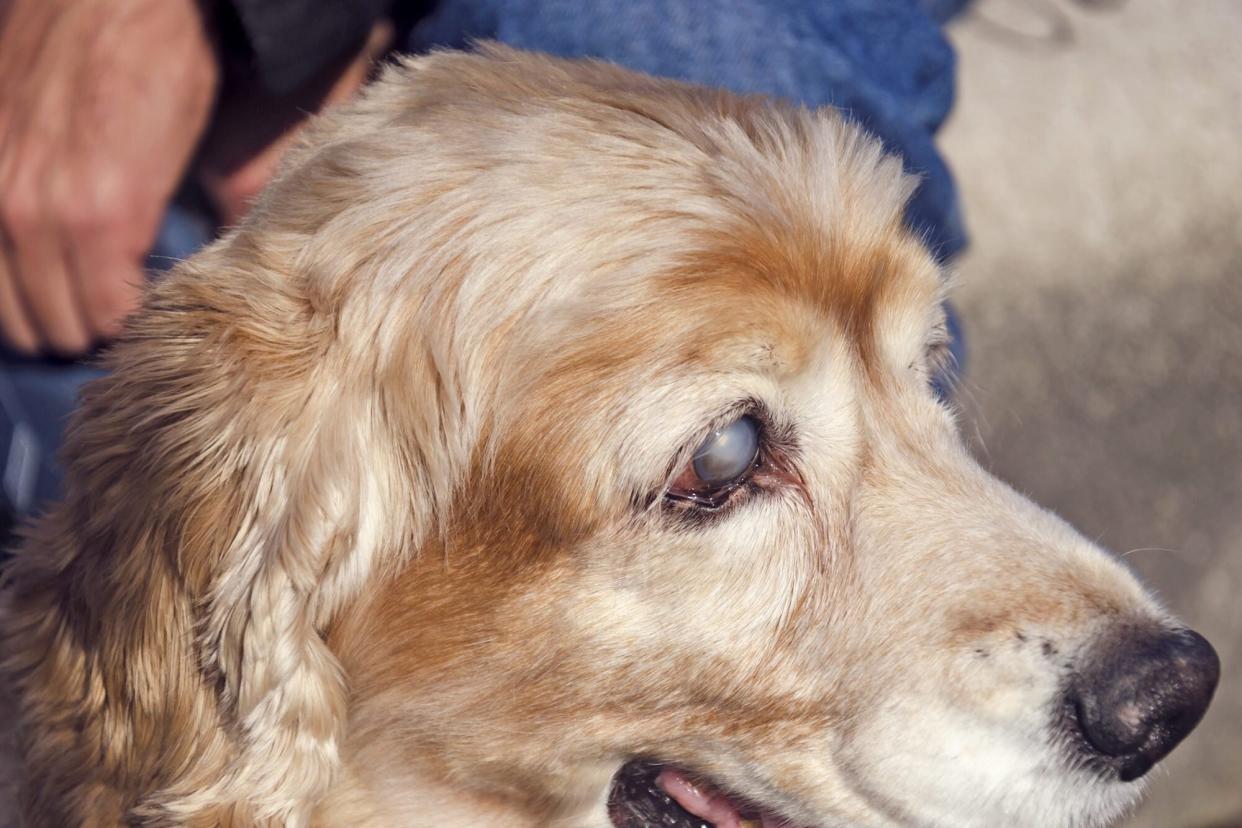Glaucoma in Dogs: Cloudy Eyes Mean You Need to Visit Your Pup's Veterinarian

Elizabeth Fernandez / Getty
TABLE OF CONTENTS
On This Page
What Is Glaucoma in Dogs?
Causes
Symptoms
Diagnosis
Treatment
Prognosis
Prevention
Our pups use their eyes for many things—exploring their environment, playing fetch, and spotting squirrels—so when problems like glaucoma in dogs arise, you'll need prompt veterinary attention.
If you notice your dog's eyes are cloudy and your dog seems to be in pain, it could be glaucoma, an often painful eye condition that requires immediate diagnosis and treatment. Here's what to expect if your dog is diagnosed with glaucoma.
RELATED: Why Are My Dog's Eyes Cloudy?
What Is Glaucoma in Dogs?
Glaucoma is an increase in intraocular pressure caused by a buildup of aqueous humor, an eye fluid that nourishes and provides oxygen throughout the eye. The fluid drains out of the eye through the filtration angle located between the iris and cornea.
An equal balance between the production and drainage of aqueous humor keeps intraocular pressure within normal limits. Pressure increases when this balance is disrupted and aqueous humor doesn't drain properly. Increased pressure damages the retina and optic disk, leading to permanent blindness.
Glaucoma in dogs is classified as primary or secondary. Primary glaucoma is inherited and involves a genetic malformation of the filtration angle, preventing adequate aqueous humor drainage. Primary glaucoma can be further classified as "open angle" or "closed angle." Primary open angle glaucoma develops gradually, while primary closed angle glaucoma (goniodysgenesis) develops rapidly.
Secondary glaucoma is the most common form of glaucoma in dogs and is caused by an underlying eye condition. Glaucoma can affect one or both eyes. Commonly, the unaffected eye will develop glaucoma within a year of the other eye developing glaucoma.
What Triggers Glaucoma in Dogs?
Glaucoma is caused by blocked drainage of aqueous humor from the eye. There are some breeds that are genetically predisposed to primary glaucoma, including:
Terrier breeds
There are various eye conditions that cause secondary glaucoma, including:
Eye inflammation
Lens luxation
Eye tumors
Eye trauma
What Are the Symptoms of Glaucoma in Dogs?
Early signs of glaucoma in dogs are hard to detect. Symptoms of glaucoma become more pronounced as the disease progresses, whether rapidly or gradually. Symptoms can include:
Vision loss
Eye rubbing
Eye redness
Drooping eyelids
Hazy, cloudy blue eye
Bulging eye (buphthalmos)
Dilated, slow-moving, and unresponsive pupil
Pain, demonstrated by squinting and excess tearing
Secondary glaucoma causes additional symptoms:
Iris sticking to the cornea
Inflammatory debris in the front of the eye
You may also observe more general symptoms:
Hiding
Reduced activity level
Head pressing to relieve pressure
Diagnosis of Glaucoma in Dogs
Schedule an appointment with your veterinarian as soon as your dog shows symptoms of glaucoma. After outlining your dog's medical history, tell your veterinarian about your dog's symptoms and when they started as well as any history of eye injuries or other eye problems.
Your vet will then perform an eye exam. They will measure intraocular pressure using a tonometer. Normal intraocular pressure in dogs is 15 to 25 mm Hg. The pressure in dogs with glaucoma can sit as high as 45 to 60 mm Hg. Your vet will also examine your dog's eyes for other abnormalities.
Your veterinarian may refer you to a veterinary ophthalmologist for advanced eye testing. One such test is a gonioscopy, which evaluates the filtration angle in dogs with goniodysgenesis. Another advanced eye test is electroretinography, which assesses retinal function.
Both eyes will be examined, even if only one eye is affected.
Glaucoma in Dogs Treatment
Glaucoma is treated as a medical emergency, given the risk of permanent blindness that can happen within hours if intraocular pressure isn't reduced. Treatment via medicine or surgery will hopefully reduce intraocular pressure, reduce pain, increase aqueous humor drainage, and decrease aqueous humor production.
Some medications will increase aqueous humor drainage and decrease its production; others include pain relievers. Both are given as pills or eye drops and are administered if there's no vision loss. If there is vision loss, surgical therapies become the best treatment option.
Cyclocryotherapy is a non-invasive surgical procedure that freezes aqueous humor-producing cells. Goniovalve surgical therapy creates another path for aqueous humor to exit the eye. Enucleation, or complete eye removal, is for end-stage glaucoma in dogs when there is permanent blindness.
Your veterinarian will determine the best treatment option for your dog according to the type of glaucoma your dog has and how advanced it is. Treatment is usually long-term and requires regular monitoring of the affected and unaffected eye.
What's the Prognosis of Glaucoma in Dogs?
Glaucoma has no cure. Long-term medical therapy often fails and dogs become blind, necessitating surgery. Fortunately, dogs adjust to vision loss quite well and can still enjoy their lives.
RELATED: 6 Strategies to Help You Properly Care for a Blind or Visually Impaired Dog
How to Prevent Glaucoma in Dogs
Primary glaucoma cannot be prevented because it's inherited. However, if you have a breed that is predisposed to glaucoma, regular eye monitoring can detect glaucoma early so treatment can begin as soon as possible.
Preventing eye injury is the main way to prevent secondary glaucoma in dogs.

